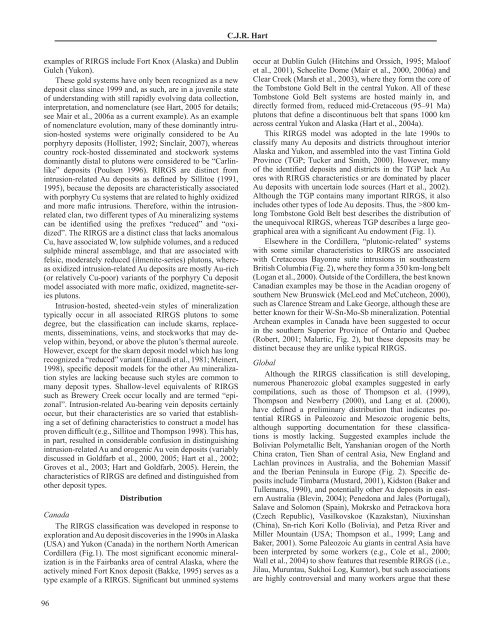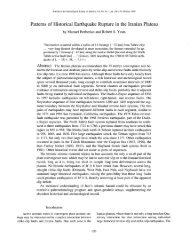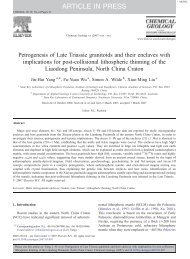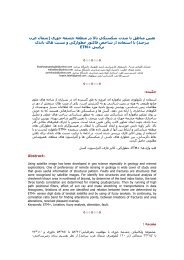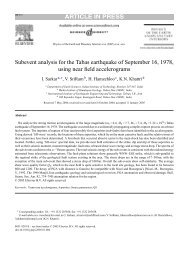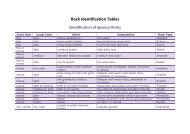Reduced Intrusion-Related Gold System - GSINET | Geological ...
Reduced Intrusion-Related Gold System - GSINET | Geological ...
Reduced Intrusion-Related Gold System - GSINET | Geological ...
You also want an ePaper? Increase the reach of your titles
YUMPU automatically turns print PDFs into web optimized ePapers that Google loves.
C.J.R. Hart<br />
examples of RIRGS include Fort Knox (Alaska) and Dublin<br />
Gulch (Yukon).<br />
These gold systems have only been recognized as a new<br />
deposit class since 1999 and, as such, are in a juvenile state<br />
of understanding with still rapidly evolving data collection,<br />
interpretation, and nomenclature (see Hart, 2005 for details;<br />
see Mair et al., 2006a as a current example). As an example<br />
of nomenclature evolution, many of these dominantly intrusion-hosted<br />
systems were originally considered to be Au<br />
porphyry deposits (Hollister, 1992; Sinclair, 2007), whereas<br />
country rock-hosted disseminated and stockwork systems<br />
dominantly distal to plutons were considered to be “Carlinlike”<br />
deposits (Poulsen 1996). RIRGS are distinct from<br />
intrusion-related Au deposits as defined by Sillitoe (1991,<br />
1995), because the deposits are characteristically associated<br />
with porphyry Cu systems that are related to highly oxidized<br />
and more mafic intrusions. Therefore, within the intrusionrelated<br />
clan, two different types of Au mineralizing systems<br />
can be identified using the prefixes “reduced” and “oxidized”.<br />
The RIRGS are a distinct class that lacks anomalous<br />
Cu, have associated W, low sulphide volumes, and a reduced<br />
sulphide mineral assemblage, and that are associated with<br />
felsic, moderately reduced (ilmenite-series) plutons, whereas<br />
oxidized intrusion-related Au deposits are mostly Au-rich<br />
(or relatively Cu-poor) variants of the porphyry Cu deposit<br />
model associated with more mafic, oxidized, magnetite-series<br />
plutons.<br />
<strong>Intrusion</strong>-hosted, sheeted-vein styles of mineralization<br />
typically occur in all associated RIRGS plutons to some<br />
degree, but the classification can include skarns, replacements,<br />
disseminations, veins, and stockworks that may develop<br />
within, beyond, or above the pluton’s thermal aureole.<br />
However, except for the skarn deposit model which has long<br />
recognized a “reduced” variant (Einaudi et al., 1981; Meinert,<br />
1998), specific deposit models for the other Au mineralization<br />
styles are lacking because such styles are common to<br />
many deposit types. Shallow-level equivalents of RIRGS<br />
such as Brewery Creek occur locally and are termed “epizonal”.<br />
<strong>Intrusion</strong>-related Au-bearing vein deposits certainly<br />
occur, but their characteristics are so varied that establishing<br />
a set of defining characteristics to construct a model has<br />
proven difficult (e.g., Sillitoe and Thompson 1998). This has,<br />
in part, resulted in considerable confusion in distinguishing<br />
intrusion-related Au and orogenic Au vein deposits (variably<br />
discussed in <strong>Gold</strong>farb et al., 2000, 2005; Hart et al., 2002;<br />
Groves et al., 2003; Hart and <strong>Gold</strong>farb, 2005). Herein, the<br />
characteristics of RIRGS are defined and distinguished from<br />
other deposit types.<br />
Distribution<br />
Canada<br />
The RIRGS classification was developed in response to<br />
exploration and Au deposit discoveries in the 1990s in Alaska<br />
(USA) and Yukon (Canada) in the northern North American<br />
Cordillera (Fig.1). The most significant economic mineralization<br />
is in the Fairbanks area of central Alaska, where the<br />
actively mined Fort Knox deposit (Bakke, 1995) serves as a<br />
type example of a RIRGS. Significant but unmined systems<br />
occur at Dublin Gulch (Hitchins and Orssich, 1995; Maloof<br />
et al., 2001), Scheelite Dome (Mair et al., 2000, 2006a) and<br />
Clear Creek (Marsh et al., 2003), where they form the core of<br />
the Tombstone <strong>Gold</strong> Belt in the central Yukon. All of these<br />
Tombstone <strong>Gold</strong> Belt systems are hosted mainly in, and<br />
directly formed from, reduced mid-Cretaceous (95–91 Ma)<br />
plutons that define a discontinuous belt that spans 1000 km<br />
across central Yukon and Alaska (Hart et al., 2004a).<br />
This RIRGS model was adopted in the late 1990s to<br />
classify many Au deposits and districts throughout interior<br />
Alaska and Yukon, and assembled into the vast Tintina <strong>Gold</strong><br />
Province (TGP; Tucker and Smith, 2000). However, many<br />
of the identified deposits and districts in the TGP lack Au<br />
ores with RIRGS characteristics or are dominated by placer<br />
Au deposits with uncertain lode sources (Hart et al., 2002).<br />
Although the TGP contains many important RIRGS, it also<br />
includes other types of lode Au deposits. Thus, the >800 kmlong<br />
Tombstone <strong>Gold</strong> Belt best describes the distribution of<br />
the unequivocal RIRGS, whereas TGP describes a large geographical<br />
area with a significant Au endowment (Fig. 1).<br />
Elsewhere in the Cordillera, “plutonic-related” systems<br />
with some similar characteristics to RIRGS are associated<br />
with Cretaceous Bayonne suite intrusions in southeastern<br />
British Columbia (Fig. 2), where they form a 350 km-long belt<br />
(Logan et al., 2000). Outside of the Cordillera, the best known<br />
Canadian examples may be those in the Acadian orogeny of<br />
southern New Brunswick (McLeod and McCutcheon, 2000),<br />
such as Clarence Stream and Lake George, although these are<br />
better known for their W-Sn-Mo-Sb mineralization. Potential<br />
Archean examples in Canada have been suggested to occur<br />
in the southern Superior Province of Ontario and Quebec<br />
(Robert, 2001; Malartic, Fig. 2), but these deposits may be<br />
distinct because they are unlike typical RIRGS.<br />
Global<br />
Although the RIRGS classification is still developing,<br />
numerous Phanerozoic global examples suggested in early<br />
compilations, such as those of Thompson et al. (1999),<br />
Thompson and Newberry (2000), and Lang et al. (2000),<br />
have defined a preliminary distribution that indicates potential<br />
RIRGS in Paleozoic and Mesozoic orogenic belts,<br />
although supporting documentation for these classifications<br />
is mostly lacking. Suggested examples include the<br />
Bolivian Polymetallic Belt, Yanshanian orogen of the North<br />
China craton, Tien Shan of central Asia, New England and<br />
Lachlan provinces in Australia, and the Bohemian Massif<br />
and the Iberian Peninsula in Europe (Fig. 2). Specific deposits<br />
include Timbarra (Mustard, 2001), Kidston (Baker and<br />
Tullemans, 1990), and potentially other Au deposits in eastern<br />
Australia (Blevin, 2004); Penedona and Jales (Portugal),<br />
Salave and Solomon (Spain), Mokrsko and Petrackova hora<br />
(Czech Republic), Vasilkovskoe (Kazakstan), Niuxinshan<br />
(China), Sn-rich Kori Kollo (Bolivia), and Petza River and<br />
Miller Mountain (USA; Thompson et al., 1999; Lang and<br />
Baker, 2001). Some Paleozoic Au giants in central Asia have<br />
been interpreted by some workers (e.g., Cole et al., 2000;<br />
Wall et al., 2004) to show features that resemble RIRGS (i.e.,<br />
Jilau, Muruntau, Sukhoi Log, Kumtor), but such associations<br />
are highly controversial and many workers argue that these<br />
96


